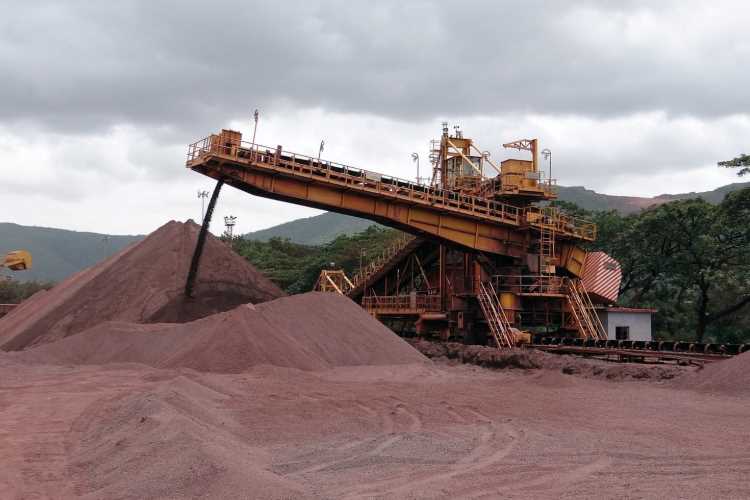
Mining in Goa came to a grinding halt on March 16, 2018 when the Supreme Court quashed the second renewal of 88 mining leases and imposed a ban on mining operations in the state. Mining and tourism are the mainstays of the Goa economy. At present, both the sectors are in big trouble – mining is banned and the tourism industry has been hit by the Covid-19 outbreak. As the tourism sector will continue to reel under the twin impacts of the coronavirus pandemic and the economic slowdown, it is important that the mining stalemate is solved without any further delay to ensure the economic well-being of Goa’s 15 lakh people.
Mining has been stalled in Goa ever since the Supreme Court quashed renewal orders of mining leases in the state. This decision directly impacted 60,000 households and 2.5 lakh direct stakeholders. It has disrupted an entire eco-system of allied industries, including logistics suppliers, truck companies, barge owners, equipment suppliers, machinery owners and ports. Mining was Goa’s largest industry in 2018. The economic losses are put at Rs 3,500 crore in the first year.
READ I Indian Railways: Government must lift veil of confusion before privatisation
The impact of the mining stalemate on the state’s economy is huge as it has a bearing on the livelihoods of a fifth of Goan population. The mining industry earned foreign exchange to the tune of $3.3 billion in 2011-2012. Apart from the revenue benefits, 2,50,000 direct stakeholders eared a living out of the industry, not to mention many more who indirectly benefited. After the 2012 suspension, the cumulative earnings of the industry were just $200 million over eight years. Goa was one of the richest states when its mining industry was working in full capacity. After the mining shutdown of industry that was contributing 20% to the state’s GDP, the state’s debt has increased by over 120%.
Over the last 70 years, the mining industry in Goa has invested in logistics and created a niche in international market. Goa Mineral Ore Exporters’ Association (GMOEA) is the apex trade association representing the mineral ore Industry in the state. Financial institutions have Rs 850 crore exposure to the Goa mining industry. Total advances to the industry exceed Rs 1000 crore.
READ I Wrong prescription: Lax labour laws will harm industry, economy
There are around 20,000 trucks used in mining operations, of which 12,546 are engaged in transportation of iron ore. The stoppage of mining operations has impacted the truck owners, drivers, operators, and sailors who were directly dependent on the mining industry. It has also affected the banking sector, particularly small co-operative banks, which had advanced loans to truck owners. Mounting dues from the sector has affected the financial stability of small co-operative banks.
There are around 375 barges used for mining transportation, of which 223 have been registered so far with the mining department in the state and are engaged in transportation of mining ore. Stalling of the mining activity has stopped all barge transport, affecting their owners, staff and families. There are around 220 mining machineries registered with the state department of mines and geology.
Revenue gains for stakeholders from the resumption of mining would be substantial. The mining industry alone will generate more than Rs 3,500 crore per annum. The foreign exchange reserves will gain by $800 million at current price levels, assuming a maximum extraction of 20 million tonne.
READ I Policy and Judiciary: A vision for post-Covid India
All these numbers demonstrate the economic impact of the stalling of the mining industry. It has affected the entire population of the state. Apart from this, this has directly affected the state’s revenues, resulting in a loss of more than Rs 3,500 crore.
Steps to restart mining should be consistent and credible and must follow a holistic approach. The state government as well as the industry are keen to end the stalemate. The state assembly unanimously requested the Union government to restart the mining operations at the earliest.
READ I Covid-19 explainer: All you need to know about how coronavirus is transmitted
The situation in Goa is critical as mining companies maintained all their employees despite eight years of shutdown. Assets are being maintained, mines are being maintained, and environmental measures are being taken despite the suspension of mining operations. Goa can effectively commence mining within three months once the clearances are in place. Besides Goa has lost its market share to Brazil and Australia and it will take some time to reclaim the market. Clarity of tenure of leases is key to any attempt to regain lost markets.
Restarting the mining operations in Goa will improve the country’s trade balance and the foreign exchange reserves. It is also vital for the prosperity of the people of Goa and the economy of the state. The arguments made in this article highlights the concerns of the Goa government and the Union government by offering a holistic approach towards a self-reliant economy.
READ I How can India correct trade imbalance with China
The study proposes a following set of solutions to end the stalemate at the earliest:
- The concessionaries filed an SLP in the Supreme Court and got an interim relief. The SLP is still pending before the constitution bench of the Supreme Court. This SLP needs to be withdrawn by the concessionaries.
- The Union government must come forward to resolve the issue of the date of applicability of the Abolition Act 1987 and the MMDR amendment of 2015/20 by accepting the prospective time period of lease from the introduction of Abolition Act on May 23, 1987 for 50 years (till 2037).
- Section 8(A 3) of MMDR Act 1957 read with 8(A 6) does provide that all mining lease granted prior to 2015 shall be deemed to have been granted for 50 years.
- In its judgment of February 7, 2018, the Supreme Court made it clear that mining in Goa will cease until fresh mining leases (not fresh renewals or other renewals) are granted and fresh environmental clearances are granted. Thus, accepting the date of application of the Abolition Act 1987 with prospective effect from May 23, 1987, the existing mining concessions/leases of Goa can be considered deemed to have been granted for 50 years with effect from May 23, 1987 as per Section 8(A)(3) of MMDR Act, 1957. It will make a beginning to end the stalemate.
- To have clear-cut directions ensuring various steps to be taken to address the challenges in a time-bound manner for sustainable mining in Goa.
There is a need to have credible and consistent action to enable restart of mining after the monsoon season. The environment clearances of two years given to the existing mines during auctions in rest of the country should be extended to mines in Goa. All the above recommendations need to be implemented immediately to facilitate the restart of mining operations in Goa.
(Dr Aruna Sharma is a Delhi-based development economist and a former civil servant. She retired as secretary, ministry of steel, government of India in 2018.)
Dr Aruna Sharma is a New Delhi-based development economist. She is a 1982-batch Indian Administrative Service officer. She retired as steel secretary in 2018.

